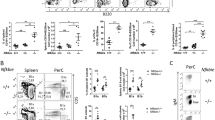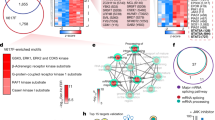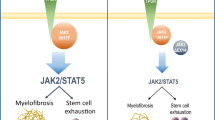Abstract
The pathogenesis of chronic lymphocytic leukemia (CLL) has been linked to constitutive NF-κB activation but the underlying mechanisms are poorly understood. Here we show that alternative splicing of the negative regulator of NF-κB and tumor suppressor gene CYLD regulates the pool of CD5+ B cells through sustained canonical NF-κB signaling. Reinforced canonical NF-κB activity leads to the development of B1 cell-associated tumor formation in aging mice by promoting survival and proliferation of CD5+ B cells, highly reminiscent of human B-CLL. We show that a substantial number of CLL patient samples express sCYLD, strongly implicating a role for it in human B-CLL. We propose that our new CLL-like mouse model represents an appropriate tool for studying ubiquitination-driven canonical NF-κB activation in CLL. Thus, inhibition of alternative splicing of this negative regulator is essential for preventing NF-κB-driven clonal CD5+ B-cell expansion and ultimately CLL-like disease.
This is a preview of subscription content, access via your institution
Access options
Subscribe to this journal
Receive 12 print issues and online access
$259.00 per year
only $21.58 per issue
Buy this article
- Purchase on Springer Link
- Instant access to full article PDF
Prices may be subject to local taxes which are calculated during checkout








Similar content being viewed by others
References
Kipps TJ . Immunobiology of chronic lymphocytic leukemia. Curr Opin Hematol 2003; 10: 312–318.
Rosati E, Sabatini R, Rampino G, Tabilio A, Di Ianni M, Fettucciari K et al. Constitutively activated Notch signaling is involved in survival and apoptosis resistance of B-CLL cells. Blood 2009; 113: 856–865.
Cuni S, Perez-Aciego P, Perez-Chacon G, Vargas JA, Sanchez A, Martin-Saavedra FM et al. A sustained activation of PI3K/NF-kappaB pathway is critical for the survival of chronic lymphocytic leukemia B cells. Leukemia 2004; 18: 1391–1400.
Schuh K, Avots A, Tony HP, Serfling E, Kneitz C . Nuclear NF-ATp is a hallmark of unstimulated B cells from B-CLL patients. Leuk Lymphoma 1996; 23: 583–592.
Furman RR, Asgary Z, Mascarenhas JO, Liou HC, Schattner EJ . Modulation of NF-kappa B activity and apoptosis in chronic lymphocytic leukemia B cells. J Immunol 2000; 164: 2200–2206.
Liu Z, Hazan-Halevy I, Harris DM, Li P, Ferrajoli A, Faderl S et al. STAT-3 activates NF-kappaB in chronic lymphocytic leukemia cells. Mol Cancer Res 2011; 9: 507–515.
Mansouri L, Papakonstantinou N, Ntoufa S, Stamatopoulos K, Rosenquist R . NF-kappaB activation in chronic lymphocytic leukemia: a point of convergence of external triggers and intrinsic lesions. Semin Cancer Biol 2016; 39: 40–48.
Malynn BA, Ma A . Ubiquitin makes its mark on immune regulation. Immunity 2010; 33: 843–852.
Massoumi R . Ubiquitin chain cleavage: CYLD at work. Trends Biochem Sci 2010; 35: 392–399.
Hymowitz SG, Wertz IE . A20: from ubiquitin editing to tumour suppression. Nat Rev Cancer 2010; 10: 332–341.
Mathis BJ, Lai Y, Qu C, Janicki JS, Cui T . CYLD-mediated signaling and diseases. Curr Drug Targets 2015; 16: 284–294.
Hovelmeyer N, Wunderlich FT, Massoumi R, Jakobsen CG, Song J, Worns MA et al. Regulation of B cell homeostasis and activation by the tumor suppressor gene CYLD. J Exp Med 2007; 204: 2615–2627.
van Andel H, Kocemba KA, de Haan-Kramer A, Mellink CH, Piwowar M, Broijl A et al. Loss of CYLD expression unleashes Wnt signaling in multiple myeloma and is associated with aggressive disease. Oncogene 2017; 36: 2105–2115.
Liu P, Xu B, Shen W, Zhu H, Wu W, Fu Y et al. Dysregulation of TNFalpha-induced necroptotic signaling in chronic lymphocytic leukemia: suppression of CYLD gene by LEF1. Leukemia 2012; 26: 1293–1300.
Wu W, Zhu H, Fu Y, Shen W, Xu J, Miao K et al. Clinical significance of down-regulated cylindromatosis gene in chronic lymphocytic leukemia. Leuk Lymphoma 2014; 55: 588–594.
Tavares RM, Turer EE, Liu CL, Advincula R, Scapini P, Rhee L et al. The ubiquitin modifying enzyme A20 restricts B cell survival and prevents autoimmunity. Immunity 2010; 33: 181–191.
Chu Y, Vahl JC, Kumar D, Heger K, Bertossi A, Wojtowicz E et al. B cells lacking the tumor suppressor TNFAIP3/A20 display impaired differentiation and hyperactivation and cause inflammation and autoimmunity in aged mice. Blood 2011; 117: 2227–2236.
Hovelmeyer N, Reissig S, Xuan NT, Adams-Quack P, Lukas D, Nikolaev A et al. A20 deficiency in B cells enhances B-cell proliferation and results in the development of autoantibodies. Eur J Immunol 2011; 41: 595–601.
Philipp C, Edelmann J, Buhler A, Winkler D, Stilgenbauer S, Kuppers R . Mutation analysis of the TNFAIP3 (A20) tumor suppressor gene in CLL. Int J Cancer 2011; 128: 1747–1750.
Frenzel LP, Claus R, Plume N, Schwamb J, Konermann C, Pallasch CP et al. Sustained NF-kappaB activity in chronic lymphocytic leukemia is independent of genetic and epigenetic alterations in the TNFAIP3 (A20) locus. Int J Cancer 2011; 128: 2495–2500.
Kantor AB, Herzenberg LA . Origin of murine B cell lineages. Annu Rev Immunol 1993; 11: 501–538.
Pritsch O, Magnac C, Dumas G, Egile C, Dighiero G . V gene usage by seven hybrids derived from CD5+ B-cell chronic lymphocytic leukemia and displaying autoantibody activity. Blood 1993; 82: 3103–3112.
Stevenson FK, Caligaris-Cappio F . Chronic lymphocytic leukemia: revelations from the B-cell receptor. Blood 2004; 103: 4389–4395.
Herishanu Y, Perez-Galan P, Liu D, Biancotto A, Pittaluga S, Vire B et al. The lymph node microenvironment promotes B-cell receptor signaling, NF-kappaB activation, and tumor proliferation in chronic lymphocytic leukemia. Blood 2011; 117: 563–574.
Matutes E, Polliack A . Morphological and immunophenotypic features of chronic lymphocytic leukemia. Rev Clin Exp Hematol 2000; 4: 22–47.
Drillenburg P, Pals ST . Cell adhesion receptors in lymphoma dissemination. Blood 2000; 95: 1900–1910.
Bichi R, Shinton SA, Martin ES, Koval A, Calin GA, Cesari R et al. Human chronic lymphocytic leukemia modeled in mouse by targeted TCL1 expression. Proc Natl Acad Sci USA 2002; 99: 6955–6960.
Bashford-Rogers RJ, Palser AL, Huntly BJ, Rance R, Vassiliou GS, Follows GA et al. Network properties derived from deep sequencing of human B-cell receptor repertoires delineate B-cell populations. Genome Res 2013; 23: 1874–1884.
Ghia P, Stamatopoulos K, Belessi C, Moreno C, Stilgenbauer S, Stevenson F et al. ERIC recommendations on IGHV gene mutational status analysis in chronic lymphocytic leukemia. Leukemia 2007; 21: 1–3.
Forster I, Rajewsky K . Expansion and functional activity of Ly-1+ B cells upon transfer of peritoneal cells into allotype-congenic, newborn mice. Eur J Immunol 1987; 17: 521–528.
Enzler T, Kater AP, Zhang W, Widhopf GF 2nd, Chuang HY, Lee J et al. Chronic lymphocytic leukemia of Emu-TCL1 transgenic mice undergoes rapid cell turnover that can be offset by extrinsic CD257 to accelerate disease progression. Blood 2009; 114: 4469–4476.
Dejardin E, Droin NM, Delhase M, Haas E, Cao Y, Makris C et al. The lymphotoxin-beta receptor induces different patterns of gene expression via two NF-kappaB pathways. Immunity 2002; 17: 525–535.
Fusco AJ, Savinova OV, Talwar R, Kearns JD, Hoffmann A, Ghosh G . Stabilization of RelB requires multidomain interactions with p100/p52. J Biol Chem 2008; 283: 12324–12332.
Mineva ND, Rothstein TL, Meyers JA, Lerner A, Sonenshein GE . CD40 ligand-mediated activation of the de novo RelB NF-kappaB synthesis pathway in transformed B cells promotes rescue from apoptosis. J Biol Chem 2007; 282: 17475–17485.
Lopez-Guerra M, Colomer D . NF-kappaB as a therapeutic target in chronic lymphocytic leukemia. Expert Opin Ther Targets 2010; 14: 275–288.
Duhren-von Minden M, Ubelhart R, Schneider D, Wossning T, Bach MP, Buchner M et al. Chronic lymphocytic leukaemia is driven by antigen-independent cell-autonomous signalling. Nature 2012; 489: 309–312.
Buggins AG, Pepper C, Patten PE, Hewamana S, Gohil S, Moorhead J et al. Interaction with vascular endothelium enhances survival in primary chronic lymphocytic leukemia cells via NF-kappaB activation and de novo gene transcription. Cancer Res 2010; 70: 7523–7533.
Zapata JM, Krajewska M, Morse HC 3rd, Choi Y, Reed JC . TNF receptor-associated factor (TRAF) domain and Bcl-2 cooperate to induce small B cell lymphoma/chronic lymphocytic leukemia in transgenic mice. Proc Natl Acad Sci USA 2004; 101: 16600–16605.
Klein U, Dalla-Favera R . New insights into the pathogenesis of chronic lymphocytic leukemia. Semin Cancer Biol 2010; 20: 377–383.
Planelles L, Carvalho-Pinto CE, Hardenberg G, Smaniotto S, Savino W, Gomez-Caro R et al. APRIL promotes B-1 cell-associated neoplasm. Cancer Cell 2004; 6: 399–408.
Pekarsky Y, Palamarchuk A, Maximov V, Efanov A, Nazaryan N, Santanam U et al. Tcl1 functions as a transcriptional regulator and is directly involved in the pathogenesis of CLL. Proc Natl Acad Sci USA 2008; 105: 19643–19648.
Puente XS, Bea S, Valdes-Mas R, Villamor N, Gutierrez-Abril J, Martin-Subero JI et al. Non-coding recurrent mutations in chronic lymphocytic leukaemia. Nature 2015; 526: 519–524.
Landau DA, Carter SL, Stojanov P, McKenna A, Stevenson K, Lawrence MS et al. Evolution and impact of subclonal mutations in chronic lymphocytic leukemia. Cell 2013; 152: 714–726.
Quesada V, Ramsay AJ, Lopez-Otin C . Chronic lymphocytic leukemia with SF3B1 mutation. N Engl J Med 2012; 366: 2530.
Rossi D, Fangazio M, Rasi S, Vaisitti T, Monti S, Cresta S et al. Disruption of BIRC3 associates with fludarabine chemorefractoriness in TP53 wild-type chronic lymphocytic leukemia. Blood 2012; 119: 2854–2862.
Mansouri L, Sutton LA, Ljungstrom V, Bondza S, Arngarden L, Bhoi S et al. Functional loss of IkappaBepsilon leads to NF-kappaB deregulation in aggressive chronic lymphocytic leukemia. J Exp Med 2015; 212: 833–843.
Petlickovski A, Laurenti L, Li X, Marietti S, Chiusolo P, Sica S et al. Sustained signaling through the B-cell receptor induces Mcl-1 and promotes survival of chronic lymphocytic leukemia B cells. Blood 2005; 105: 4820–4827.
Barragan M, Bellosillo B, Campas C, Colomer D, Pons G, Gil J . Involvement of protein kinase C and phosphatidylinositol 3-kinase pathways in the survival of B-cell chronic lymphocytic leukemia cells. Blood 2002; 99: 2969–2976.
Endo T, Nishio M, Enzler T, Cottam HB, Fukuda T, James DF et al. BAFF and APRIL support chronic lymphocytic leukemia B-cell survival through activation of the canonical NF-kappaB pathway. Blood 2007; 109: 703–710.
Viatour P, Bentires-Alj M, Chariot A, Deregowski V, de Leval L, Merville MP et al. NF- kappa B2/p100 induces Bcl-2 expression. Leukemia 2003; 17: 1349–1356.
Xu J, Zhou P, Wang W, Sun A, Guo F . RelB, together with RelA, sustains cell survival and confers proteasome inhibitor sensitivity of chronic lymphocytic leukemia cells from bone marrow. J Mol Med 2014; 92: 77–92.
Tracey L, Perez-Rosado A, Artiga MJ, Camacho FI, Rodriguez A, Martinez N et al. Expression of the NF-kappaB targets BCL2 and BIRC5/Survivin characterizes small B-cell and aggressive B-cell lymphomas, respectively. J Pathol 2005; 206: 123–134.
Acknowledgements
We thank Marc Schmidt-Supprian for excellent scientific discussions, Petra Adams-Quack and Elena Zurkowski for technical help. We thank Linda Koch and Florian Kurschus for critically proof reading the manuscript. This project was supported by the DFG: HO 4440/1-02.
Author information
Authors and Affiliations
Corresponding author
Ethics declarations
Competing interests
The authors declare no conflict of interest.
Additional information
Supplementary Information accompanies this paper on the Leukemia website
Rights and permissions
About this article
Cite this article
Hahn, M., Bürckert, JP., Luttenberger, C. et al. Aberrant splicing of the tumor suppressor CYLD promotes the development of chronic lymphocytic leukemia via sustained NF-κB signaling. Leukemia 32, 72–82 (2018). https://doi.org/10.1038/leu.2017.168
Received:
Revised:
Accepted:
Published:
Issue Date:
DOI: https://doi.org/10.1038/leu.2017.168
This article is cited by
-
Deubiquitinases in hematological malignancies
Biomarker Research (2021)
-
The role of deubiquitinating enzymes in cancer drug resistance
Cancer Chemotherapy and Pharmacology (2020)
-
Elevated Kallikrein-binding protein in diabetes impairs wound healing through inducing macrophage M1 polarization
Cell Communication and Signaling (2019)
-
Epigenetic modifiers DNMT3A and BCOR are recurrently mutated in CYLD cutaneous syndrome
Nature Communications (2019)



